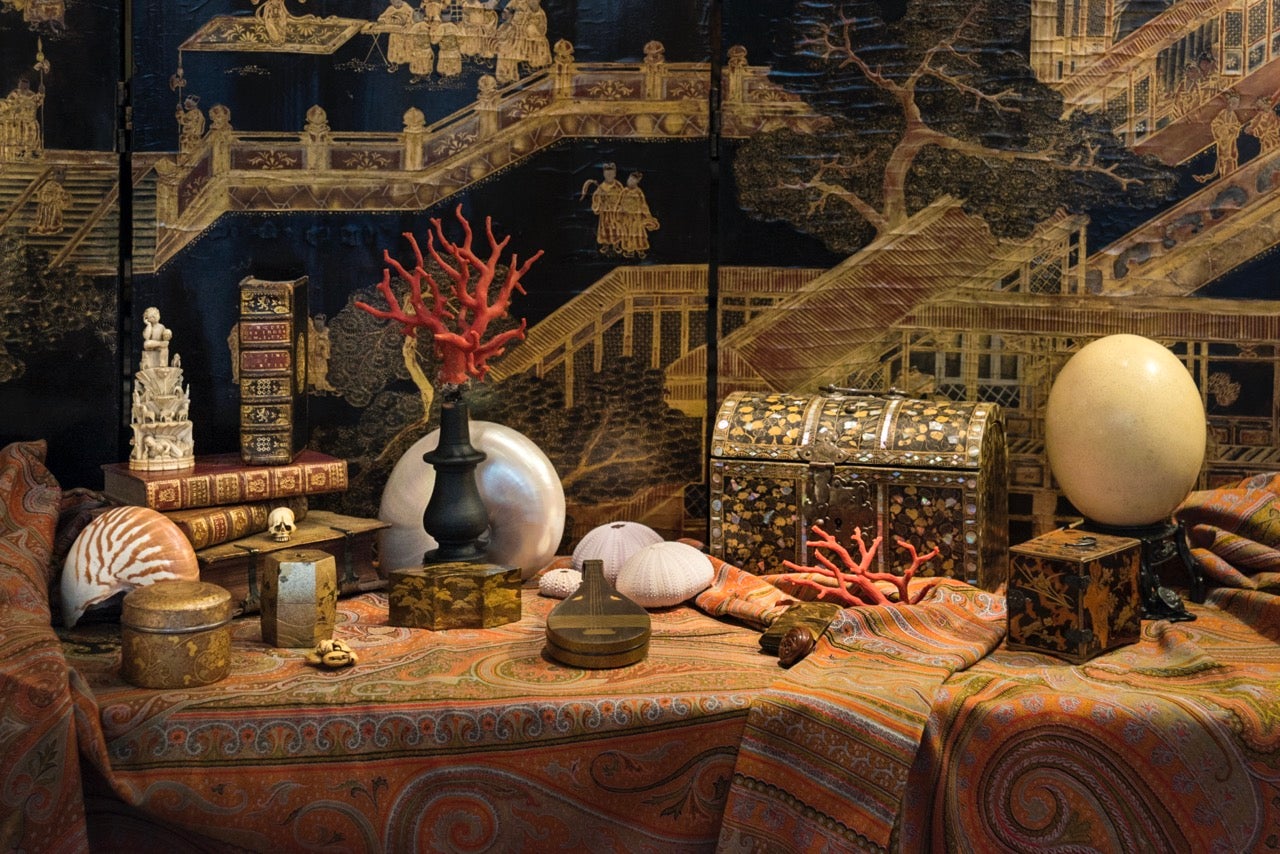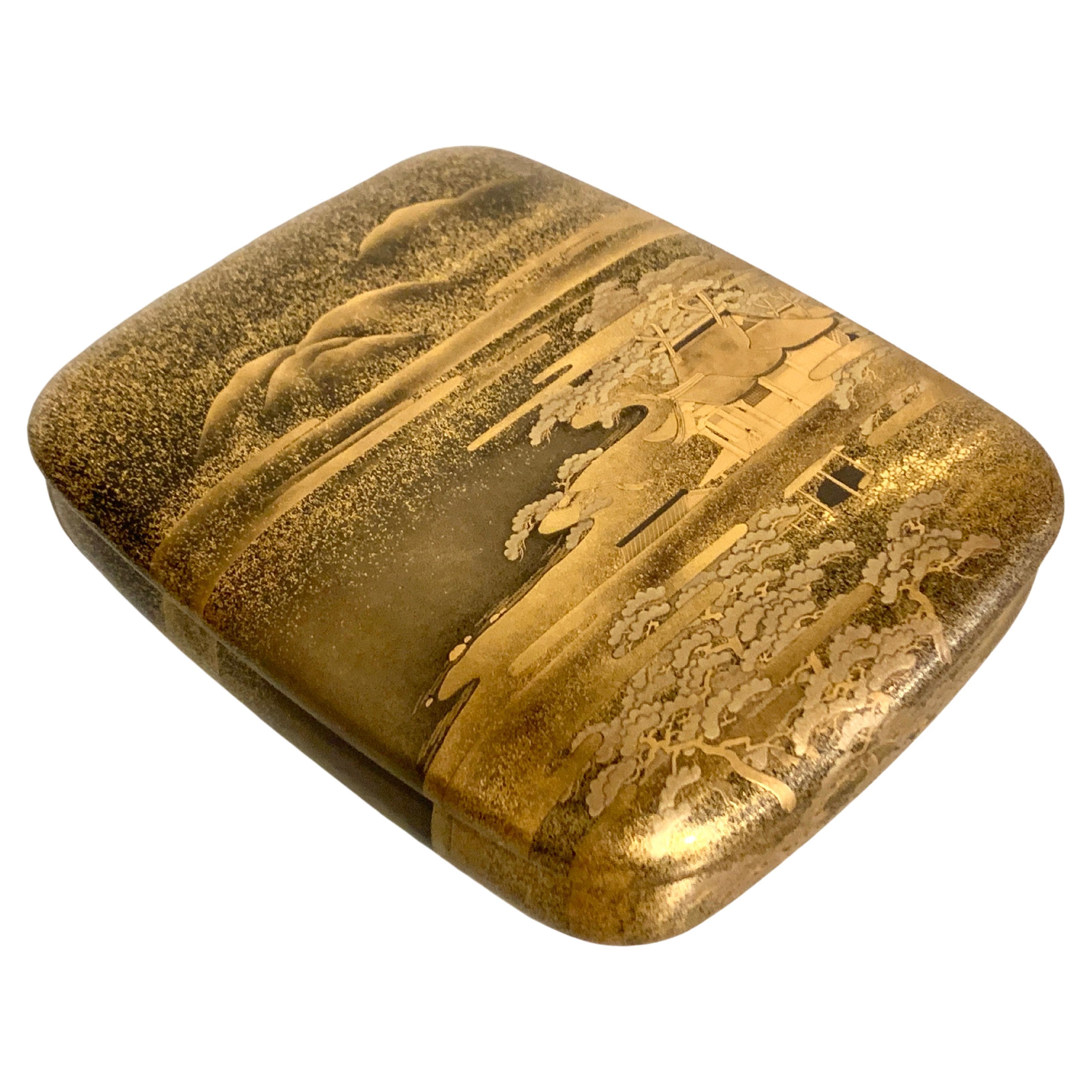Items Similar to Japanese peony basket lacquered box Edo
Want more images or videos?
Request additional images or videos from the seller
1 of 8
Japanese peony basket lacquered box Edo
About the Item
Eight-sided, flared shaped lacquer kobako box, following the decoration on the lid depicting a basket of flowers, composed of peonies and chrysanthemums in gold takamaki-e and hiramaki-e lacquer on a nashi-ji background. The edge is decorated with cherry blossoms in gold and silver takamaki-e. Interior and base in nashi-ji.
- Dimensions:Height: 3.55 in (9 cm)Width: 6.11 in (15.5 cm)Depth: 1.89 in (4.8 cm)
- Style:Edo (Of the Period)
- Materials and Techniques:
- Place of Origin:
- Period:
- Date of Manufacture:circa 1800
- Condition:
- Seller Location:PARIS, FR
- Reference Number:

About the Seller
No Reviews Yet
Vetted Seller
These experienced sellers undergo a comprehensive evaluation by our team of in-house experts.
Established in 2013
1stDibs seller since 2023
- ShippingRetrieving quote...Ships From: PARIS, France
- Return PolicyA return for this item may be initiated within 7 days of delivery.
More From This SellerView All
- Japanese suzuribako lacquered box peony riverLocated in PARIS, FRSuzuribako box (empty) in black lacquer. Gold maki-e decoration of a river bordered by peonies, one with red highlights. The edges of the lid are in gold lacquer. Nashi-ji interior.Category
Antique Late 19th Century Japanese Lacquer
MaterialsGold
- Japanese Lacquered Tebako 'Box'Located in PARIS, FRTebako box with three compartments in golden and nashi-ji lacquer, decorated with golden, red, and kirigane lacquer, golden persimmon tree leaves, among rocks. The compartments are of increasing size from the top. The decoration is in continuity. Persimmon has been cultivated in southern China for more than 2500 years and is believed to have been introduced to Japan in the 8th century. The veneer is a tree with very hard wood, similar to ebony. According to a legend, one specimen survived the atomic bombing of Nagasaki on August 9, 1945, close to the epicenter. It is therefore in Japan a symbol of strength and longevity. It is also the national fruit of the country. It is eaten as a traditional dish during New Year's Day celebrations. Tebako literally means "portable box...Category
Antique 1860s Japanese Lacquer
MaterialsLacquer
- Japanese landscape pine kobako box Edo period 18th centuryLocated in PARIS, FRRectangular black and gold lacquer kobako box decorated with pine trees in a mountain landscape in takamaki-e, kirigane and hiramaki-e lacquer. Background in nashi-ji lacquer. Surmou...Category
Antique 18th Century Japanese Lacquer
MaterialsGold
- Japanese Lacquered Furoshiki Kobako 'Box'Located in PARIS, FRRectangular and flat lacquer Kobako (small box) representing a furoshiki knot seen from above. Fundame background, furoshiki in takamaki-e with floral pattern, inside the folds of the fabric with black and gold sayagata pattern with togidashi maki-e technique. The saya (or sayagata) pattern is composed of Chinese swastikas...Category
Antique Late 19th Century Japanese Lacquer
MaterialsLacquer
- Japanese Lacquered Natsume 'Tea Box'Located in PARIS, FRNatsume in dark red lacquer, decorated with autumn leaves and cherry blossoms in hiramaki-e and nashiji. Interior in black lacquer. Maple leaves (Momiji) are celebrated in literatur...Category
Mid-20th Century Japanese Lacquer
MaterialsLacquer
- Fine Japanese Lacquer Suzuribako 'Inkstone Box'Located in PARIS, FRBlack and gold maki-e and hirame-ji lacquer box representing a branch of plum tree in bloom which is entangled in a low wall, highlighted by mother-of-pearl inlay (raden). Inner cover made of nashi-ji lacquer with mizuhiki threads and folds. These are elements, made of silk and washi paper, supposed to bring luck and happiness, intended to seal envelopes on the specifics events (gift, new year, birth, marriage, death, etc.). Shape and color of the threads vary according to the occasion celebrated and the desired meaning. Interior in nashi-ji lacquer, with water cup...Category
Antique Late 19th Century Japanese Lacquer
MaterialsLacquer
You May Also Like
- Edo Maki-e Japanese BoxLocated in Brescia, ITJapanese box with lacquer lid finely decorated with Maki-e, dating from the 18th century, mid-Edo period. The box is of special size to preserve important calligraphy. All sides of ...Category
Antique Late 18th Century Japanese Edo Lacquer
MaterialsGold Leaf
- Japanese Lacquer Stationery Box, Suzuribako, Edo Period, 19th c, JapanLocated in Austin, TXA fine and elegant Japanese lacquer box for writing implements or stationery, suzuribako, with an image of a Shinto shrine, Edo Period, mid-19th century, circa 1840, Japan. The exqu...Category
Antique Mid-19th Century Japanese Edo Lacquer
MaterialsGold Leaf
- Japanese Edo Period Igarashi School Long Lacquer Box, Tanzaku-BakoLocated in Austin, TXA stunning Japanese Edo period lacquer tanzakubako, box for poem cards, late 18th-early 19th century, Edo Period, Japan. Attributed to the Igarashi School, this box is masterfully ...Category
Antique Early 19th Century Japanese Edo Lacquer
Materials24k Gold
- Japanese Lacquer Writing Box, Suzuribako, Edo Period, 18th Century, JapanLocated in Austin, TXAn exceptionally fine and unusual Japanese lacquer writing implements box, suzuribako, in the form of a zither, koto, Edo Period, 18th century, Japan. With a modern wood storage box,...Category
Antique 18th Century Japanese Edo Lacquer
MaterialsGold, Silver, Copper
- Japanese Maki-e Lacquer Document Box, Edo Period, early 19th Century, JapanLocated in Austin, TXA spectacular Japanese maki-e lacquer lidded box, possibly a writing box, suzuribako, decorated with images of folding fans, ogi, Edo Period, earl...Category
Antique Early 19th Century Japanese Edo Lacquer
MaterialsCoral
- Japanese Lacquer Maki-E Scroll Box Fubako by Kansonsai Edo PeriodLocated in Atlanta, GAA Japanese lacquered wood fubako (a box to store document or small scroll painting) circa late 18th century of Edo period. The rectangular box features a deep lid with rounded corners and recessed mid-edge and a lower box with two bronze medallion rings and tasseled silk ties. The surface of the fubako was elaborately decorated with hiramaki-e and a low takamaki-e on a mottled Mura-nashiji background. The motifs on the lid depict branches of Japanese pine with finely rendered needles on the lower part; on the upper part, it showcases fruited persimmon branches. Two different shades of gold fundame were used to contrast the design and augmented by scattered gold kirigane to highlight some of the leaves. The design continues and cascades down to all sides of the lid as well as the walls of the box. The two bronze medallions appear original to the box and the silk ties show significant fading from the age. This Fine fubako is signed on the lower wall "Kanshosai" in Kanji with a kao mark. All the trims were finished in gold fundame and the interiors a dense nashiji in gold. Kanshosai is the mark of the distinguished lacquer artist Lizuka Toyo I who also signed his work "Toyosai". He was active in the second half of the 18th century during Edo period, employed by Hachisuka Shigeyoshi (1738-1801), daimyo of Awa on Shikoku Island. Although most survived work bearing his marks are inros, he was also known to decorated trays and other larger objects...Category
Antique Late 18th Century Japanese Edo Lacquer
MaterialsWood, Lacquer
Recently Viewed
View AllMore Ways To Browse
Antique Box Basket Japan
Lacquer Japanese Box
Chinese Fan Lacquer Box
Jo Nagasaki
Suzuri Bako
Indonesian Dowry Chest
Inro Cockerel
Silver Galery Tray
Chinese Bridal Cabinet
Large Black And Gold Hand Painted Japanese Tray
Oriental Mop
Carved Cinnabar Round Trinket Box
Cloisonne Opium Set
Japanese Hand Fan Box
Japanese Fan Box
Chinese Fan Box
Burmese Kun It
Cinnabar Round





